 Japan has suffered from deflation on and off for more than 20 years. A problem with falling prices is that they discourage spending as people wait for prices to fall further. One of the three elements of the Japanese government’s macroeconomic policy (see Japan’s three arrows) has been expansionary monetary policy, including aggressive quantitative easing. A key aim of this is to achieve an inflation target of 2% and, hopefully, propel the economy out of its deflationary trap.
Japan has suffered from deflation on and off for more than 20 years. A problem with falling prices is that they discourage spending as people wait for prices to fall further. One of the three elements of the Japanese government’s macroeconomic policy (see Japan’s three arrows) has been expansionary monetary policy, including aggressive quantitative easing. A key aim of this is to achieve an inflation target of 2% and, hopefully, propel the economy out of its deflationary trap.
The latest news, therefore, from Japan would seem to be good: consumer prices rose 0.4% in June – the first rise for more than a year. But while some analysts see the rise in prices to be partly the result of a recovery in demand (i.e. demand-pull inflation), others claim that the inflation is largely of the cost-push variety as the weaker yen has increased the price of imported fuel and food.
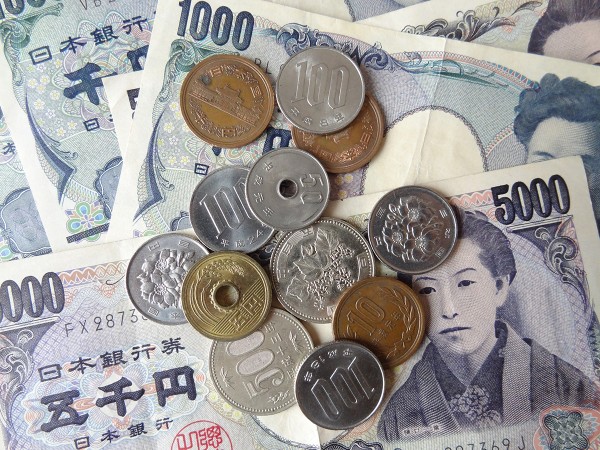 If Japanese recovery is to be sustained and broadly based, a growth in real wages should be a core component. As it is, real wages are not growing. This could seriously constrain the recovery. For real wages to grow, employers need to be convinced that economic recovery will be sustained and that it would be profitable to take on more labour.
If Japanese recovery is to be sustained and broadly based, a growth in real wages should be a core component. As it is, real wages are not growing. This could seriously constrain the recovery. For real wages to grow, employers need to be convinced that economic recovery will be sustained and that it would be profitable to take on more labour.
The success of the expansionary policy, therefore, depends in large part on its effect on expectations. Do people believe that prices will continue to rise? Do employers believe that the economy will continue to expand? And do people believe that their real wages will rise?
Articles
Japan prices turn higher, but BOJ’s goal remains tall order Reuters, Tetsushi Kajimoto and Leika Kihara (26/7/13)
How Japan Could Go from Deflation to Hyperinflation in a Heartbeat The Wall Street Journal, Michael J. Casey (24/7/13)
Japan Prices Rise Most Since ’08 in Boost for Abe Bloomberg, Toru Fujioka & Andy Sharp (26/7/13)
Japan central bank finds the pessimists come from within Reuters, Leika Kihara (26/7/13)
Japan’s Fiscal Crossroads: Will Abenomics Mean Tougher Changes? The Daily Beast, Daniel Gross (26/7/13)
Japan Economist Makes Rare Call to Tackle Debt The Wall Street Journal, Kosaku Narioka (25/7/13)
Japanese Consumer Prices Rise In Sign Of Some Success In Abe Economic Policy International Business Times, Nat Rudarakanchana (26/7/13)
Data
Bank of Japan Statistics Bank of Japan
Statistics Statistics Bureau of Japan
International sites for data Economics Network
Questions
- Distinguish between cost-push and demand-pull inflation? Do higher prices resulting from a depreciation of the currency always imply that the resulting inflation is of the cost-push variety?
- In the Japanese context, is inflation wholly desirable or are there any undesirable consequences?
- Consider whether a two-year time frame is realistic for the the Bank of Japan to achieve its 2% inflation target.
- What is meant by the output gap? Using sources such as the European Commission’s European Economy, AMECO database and the OECD’s Economic Outlook: Statistical Annex Tables (see sites 6 and 7 in the Economics Network’s links to Economic Data freely available online) trace the Japanese output gap over the past 10 years and comment on your findings.
- What supply-side constraints are likely to limit the rate and extent of recovery in Japan? What is the Japanese government doing about this (see the third arrow of Japan’s three arrows)?
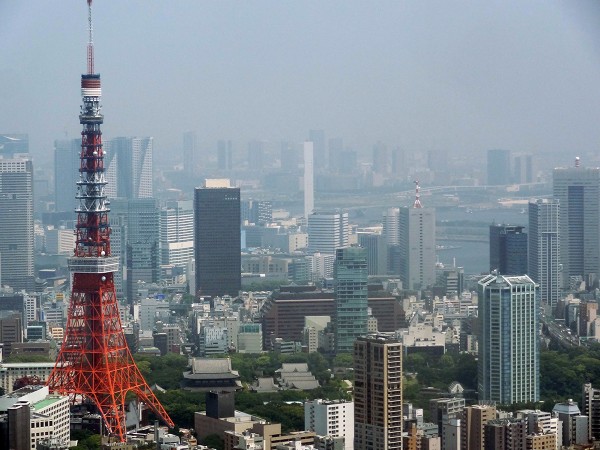 Since coming to office in December 2012, Shinzo Abe’s government has been determined to revive the Japanese economy. For the past 20 years, Japan’s growth has averaged only 0.8% per annum. This compares with 1.3% for Germany, 2.3% for the UK, 2.6% for the USA, 4.9% for South Korea and 10.4% for China.
Since coming to office in December 2012, Shinzo Abe’s government has been determined to revive the Japanese economy. For the past 20 years, Japan’s growth has averaged only 0.8% per annum. This compares with 1.3% for Germany, 2.3% for the UK, 2.6% for the USA, 4.9% for South Korea and 10.4% for China.
Japanese real GDP per capita was only 14.5% higher in 2012 than 20 years earlier. This compares with figures for Germany, the UK, the USA, South Korea and China of 27%, 45%, 34%, 126% and 497% respectively.
So what has the Japanese government done to boost both short-term and long-term growth after years of stagnation? There are ‘three arrows’ to the policy, targeted at reviving and sustaining economic growth.
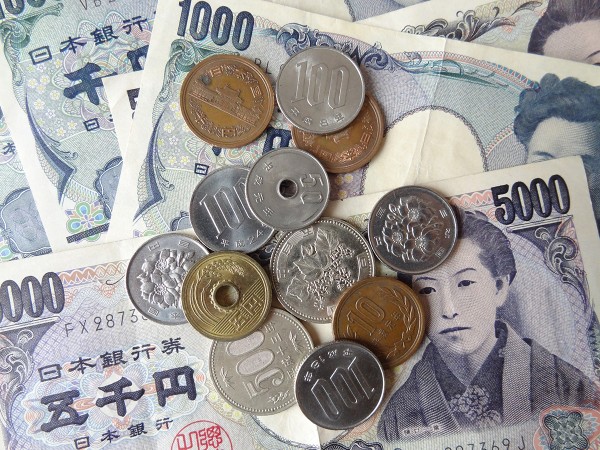 The first arrow is monetary policy. The Bank of Japan has engaged in extensive quantitative easing through bond purchases in order to drive down the exchange rate (see A J-curve for Japan?), stimulate expenditure and increase the rate of inflation. A target inflation rate of 2% has been set by the Bank of Japan. Part of the problem for the Japanese economy over the years has been stagnant or falling prices. Japanese consumers have got used to waiting to spend in the hope of being able to buy at lower prices. Similarly, Japanese businesses have often delayed stock purchase. By committing to bond purchases of whatever amount is necessary to achieve the 2% inflation target, the central bank hopes to break this cycle and encourage people to buy now rather than later.
The first arrow is monetary policy. The Bank of Japan has engaged in extensive quantitative easing through bond purchases in order to drive down the exchange rate (see A J-curve for Japan?), stimulate expenditure and increase the rate of inflation. A target inflation rate of 2% has been set by the Bank of Japan. Part of the problem for the Japanese economy over the years has been stagnant or falling prices. Japanese consumers have got used to waiting to spend in the hope of being able to buy at lower prices. Similarly, Japanese businesses have often delayed stock purchase. By committing to bond purchases of whatever amount is necessary to achieve the 2% inflation target, the central bank hopes to break this cycle and encourage people to buy now rather than later.
 The second arrow is fiscal policy. Despite having the highest debt to GDP ratio in the developed world, Japan is embarking on a large-scale programme of infrastructure investment and other public works. The package is worth over $100bn. The expansionary fiscal policy is accompanied by a longer-term plan for fiscal consolidation as economic growth picks up. In the short term, Japan should have no difficulty in financing the higher deficit, given that most of the borrowing is internal and denominated in yen.
The second arrow is fiscal policy. Despite having the highest debt to GDP ratio in the developed world, Japan is embarking on a large-scale programme of infrastructure investment and other public works. The package is worth over $100bn. The expansionary fiscal policy is accompanied by a longer-term plan for fiscal consolidation as economic growth picks up. In the short term, Japan should have no difficulty in financing the higher deficit, given that most of the borrowing is internal and denominated in yen.
 The third arrow is supply-side policy. On 5 June, Shinzo Abe unveiled a series of goals his government would like to achieve in order to boost capacity and productivity. These include increasing private-sector investment (both domestic and inward), infrastructure expenditure (both private and public), increasing farmland, encouraging more women to work by improving day-care facilities for children, and deregulation of both goods, capital and labour markets. The prime minister, however, did not give details of the measures that would be introduced to achieve these objectives. More details will be announced in mid-June.
The third arrow is supply-side policy. On 5 June, Shinzo Abe unveiled a series of goals his government would like to achieve in order to boost capacity and productivity. These include increasing private-sector investment (both domestic and inward), infrastructure expenditure (both private and public), increasing farmland, encouraging more women to work by improving day-care facilities for children, and deregulation of both goods, capital and labour markets. The prime minister, however, did not give details of the measures that would be introduced to achieve these objectives. More details will be announced in mid-June.
The following videos and articles look at the three arrows of Abenomics and the effects they are having on confidence and attitudes as well as on expenditure, output and the exchange rate. They also look at the crucial third arrow: at whether supply-side reforms will be enough to achieve a sustained increase in economic growth.
Videos
 Abenomics an uncertain future for most Financial Times on YouTube, Ben McLannahan (30/5/13)
Abenomics an uncertain future for most Financial Times on YouTube, Ben McLannahan (30/5/13)
 Assessing Abenomics NHK World (3/6/13)
Assessing Abenomics NHK World (3/6/13)
 Adam Posen on Abenomics NHK World (30/5/13)
Adam Posen on Abenomics NHK World (30/5/13)
 Japanese concerned over ‘Abenomics’ AlJazeera on YouTube (30/5/13)
Japanese concerned over ‘Abenomics’ AlJazeera on YouTube (30/5/13)
 Abenomics – the cure for deflation? BBC News, Rupert Wingfield-Hayes (10/5/13)
Abenomics – the cure for deflation? BBC News, Rupert Wingfield-Hayes (10/5/13)
 Japan PM’s economic speech ‘short on detail’ BBC News, Rupert Wingfield Hayes (5/6/13)
Japan PM’s economic speech ‘short on detail’ BBC News, Rupert Wingfield Hayes (5/6/13)
 Pretty Positive on Abenomics Bloomberg, Jan Hatzius, Goldman Sachs (5/6/13)
Pretty Positive on Abenomics Bloomberg, Jan Hatzius, Goldman Sachs (5/6/13)
 Why Abenomics is Bonkers: Pro CNBC, Graeme Maxton, (27/5/13)
Why Abenomics is Bonkers: Pro CNBC, Graeme Maxton, (27/5/13)
 ‘Abe’nomics Not About BOJ Printing Money Bloomberg, Derek Halpenny (31/5/13)
‘Abe’nomics Not About BOJ Printing Money Bloomberg, Derek Halpenny (31/5/13)
 Abenomics Aims `Third Arrow’ at Business Rules Bloomberg, Willie Pesek (5/6/13)
Abenomics Aims `Third Arrow’ at Business Rules Bloomberg, Willie Pesek (5/6/13)
 Analysis on Abe’s Growth Plan NHK World (5/6/13)
Analysis on Abe’s Growth Plan NHK World (5/6/13)
Articles
Will three arrows find their target? On Line Opinion, Andrew Leigh (6/6/13)
Japan Fires ‘Third Arrow,’ but Will It Work? CNBC, Dhara Ranasinghe (5/6/13)
Japan’s ‘3 Arrows’ May Run Into German Wall CNBC, Michael Ivanovitch (19/5/13)
Japan’s recovery – the power of Abe’s three arrows Commonwealth Bank, Australia, Melanie Timbrell (31/5/13)
So Far, the Battery Charger Is Working in Japan The New York Times, Jeff Sommer (18/5/13)
Abenomics Could Light A Fire Under The Japan Trade Again Business Insider, Matthew Boesler (4/6/13)
Japan’s New Prime Minister Unveils The ‘Most Important’ Plank Of Abenomics Business Insider (5/6/13)
Japan PM pledges to boost incomes by 30% Channel NewsAsia (5/6/13)
Abe’s growth strategy disappoints economists, investors The Asahi Shimbun (6/6/13)
Abenomics Won’t Be ’Magic Bullet’ for Japan, Says Johnson of MIT Bloomberg, Cordell Eddings (5/6/13)
Too soon to call time on Abenomics BBC News, Stephanie Flanders (19/6/13)
Abenomics: The objectives and the risks BBC News, Puneet Pal Singh (19/7/13)
Data
World Economic Outlook Database IMF
Bank of Japan Statistics Bank of Japan
Economic Outlook Annex Tables OECD
Country statistical profile: Japan 2013 OECD
Questions
- Demonstrate on (a) an aggregate demand and supply diagram and (b) a Keynesian 45° line diagram the effects of the three arrows (assuming they are successful) in meeting their objectives.
- What will determine the effectiveness of the first two arrows in boosting short-term economic growth?
- Would you characterise the policies of the third arrow as interventionist or market-orientated, or as a mixture? Explain.
- What are the dangers in ‘Abenomics’?
- Find out what has been happening to Japanese bond rates. What are the implications of this for monetary policy?
- What are the ‘markets telling Abe’?
- In what ways will expectations influence the effectiveness of Abenomics?
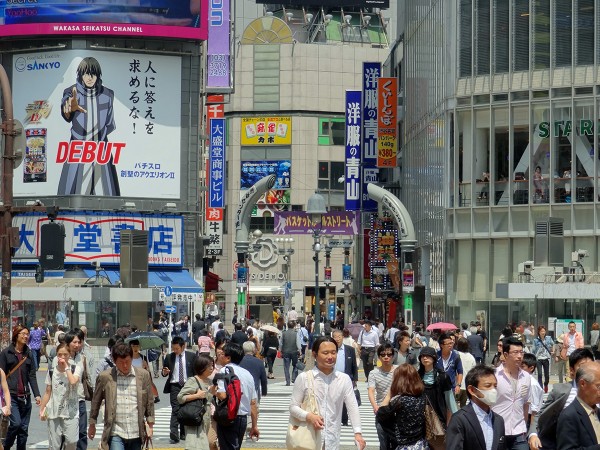 The new Japanese government under Shinzo Abe, which took office on 26 December 2012, has been pursuing a policy of weakening the yen. Using a combination of low interest rates, quantitative easing, expansionary fiscal policy and a declared aim of depreciation, the government has succeeded in driving down the value of the yen.
The new Japanese government under Shinzo Abe, which took office on 26 December 2012, has been pursuing a policy of weakening the yen. Using a combination of low interest rates, quantitative easing, expansionary fiscal policy and a declared aim of depreciation, the government has succeeded in driving down the value of the yen.
Since mid-November last year, the yen has depreciated by 28% against the dollar, 30% against the euro and 21% against sterling. The effective exchange rate index has fallen by 22% (see first diagram below: click here for a PowerPoint of the diagram).
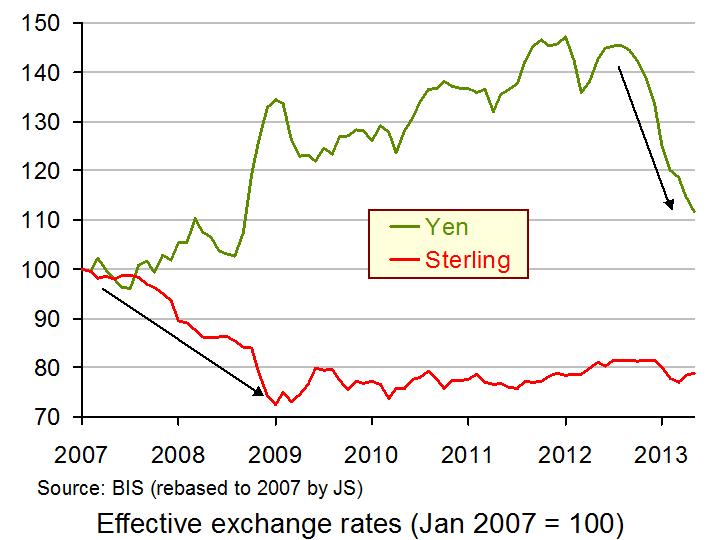 But will this depreciation succeed in stimulating the Japanese economy and will it improve the balance of trade? The hope is that the falling yen will boost export sales by making them cheaper abroad, and will reduce the demand for imports by making them more expensive in Japan. The balance of trade will thereby improve and higher exports (an injection) and lower imports (a withdrawal) will stimulate aggregate demand and economic growth.
But will this depreciation succeed in stimulating the Japanese economy and will it improve the balance of trade? The hope is that the falling yen will boost export sales by making them cheaper abroad, and will reduce the demand for imports by making them more expensive in Japan. The balance of trade will thereby improve and higher exports (an injection) and lower imports (a withdrawal) will stimulate aggregate demand and economic growth.
Traditionally Japan has run balance of trade surpluses, but since July 2012, it has been running monthly deficits – the longest run of deficits since 1980. But depreciation cannot be expected to turn this position around immediately. Indeed, theory suggests that the balance of trade is likely to deteriorate before it improves. This is known as the J-curve effect and is illustrated in the second diagram below. As page 768 of Economics, 8th edition states:
 At first a devaluation or depreciation might make a current account deficit worse: the J-curve effect. The price elasticities of demand for imports and exports may be low in the short run (see Case Study 25.1 in MyEconLab). Directly after devaluation or depreciation, few extra exports may be sold, and more will have to be paid for imports that do not have immediate substitutes. There is thus an initial deterioration in the balance of trade before it eventually improves. In Figure 25.12 [the second diagram], devaluation takes place at time t1. As you can see, the diagram has a J shape.
At first a devaluation or depreciation might make a current account deficit worse: the J-curve effect. The price elasticities of demand for imports and exports may be low in the short run (see Case Study 25.1 in MyEconLab). Directly after devaluation or depreciation, few extra exports may be sold, and more will have to be paid for imports that do not have immediate substitutes. There is thus an initial deterioration in the balance of trade before it eventually improves. In Figure 25.12 [the second diagram], devaluation takes place at time t1. As you can see, the diagram has a J shape.
Evidence suggests that the first part of the ‘J’ has been experienced in Japan: Japan’s balance of trade has deteriorated. But there is debate over whether the balance of trade will now start to improve. As the article by James Saft states:
But a look at the actual data shows Japanese companies, like British ones during a similar bout of currency weakness in 2008, appear to be more eager to use a newly competitive currency to pad profits through higher margins rather than higher export volumes. Thus far, Japanese exporters appear to be doing just that. Despite yen falls the price of Japanese exports in local currency has barely budged.
“Japanese companies have not actually cut the foreign currency prices of their exports. Just as with the UK exporters, the Japanese have chosen to hold foreign prices constant, maintain market share, and increase the yen value and thus the yen profit associated with yen depreciation,” UBS economist Paul Donovan writes in a note to clients.
 The extra profits earned by Japanese companies from export sales may be stockpiled or paid out in dividends rather than reinvested. And what investment does take place may be abroad rather than in Japan. The net effect may be very little stimulus to the Japanese economy.
The extra profits earned by Japanese companies from export sales may be stockpiled or paid out in dividends rather than reinvested. And what investment does take place may be abroad rather than in Japan. The net effect may be very little stimulus to the Japanese economy.
As stated by Saft above, the UK had a similar experience in the period 2007–9, when sterling depreciated some 27% (see the second diagram). The balance of trade improved very little and UK companies generally priced goods to markets abroad rather than cutting overseas prices.
But times were different then. The world was plunging into recession. Now global markets are mildly growing or static. Nevertheless, there is a danger that the upward slope of the J-curve in Japan may be pretty flat.
Articles
Weak yen a boon for investors, not Japan Reuters, James Saft (14/5/13)
Japan’s Trade Data Suggest Even Lower Yen Needed Wall Street Journal, Nick Hastings (22/5/13)
2 Misunderstandings About Japanese Trade Seeking Alpha, Marc Chandler (22/5/13)
Japanese trade deficit widens Financial Times, Ben McLannahan (22/5/13)
Data
BIS effective exchange rate indices Bank for International Settlements
Japan’s balance of trade Trading Economics
UK Trade, March 2013 ONS
Questions
- Explain the J-curve effect.
- Why is there some doubt about whether the Japanese balance of trade will improve significantly?
- What will be the consequences for Japanese growth?
- If foreign currency prices of Japanese exports do not change, what will determine the amount that Japan exports?
- What other measures is the Japanese government taking to stimulate the economy? What will determine the size of the multiplier effects of these measures?
- Using data from the ONS plot the UK’s quarterly balance of trade figures from 2007 to the present day. Explain the pattern that emerges.
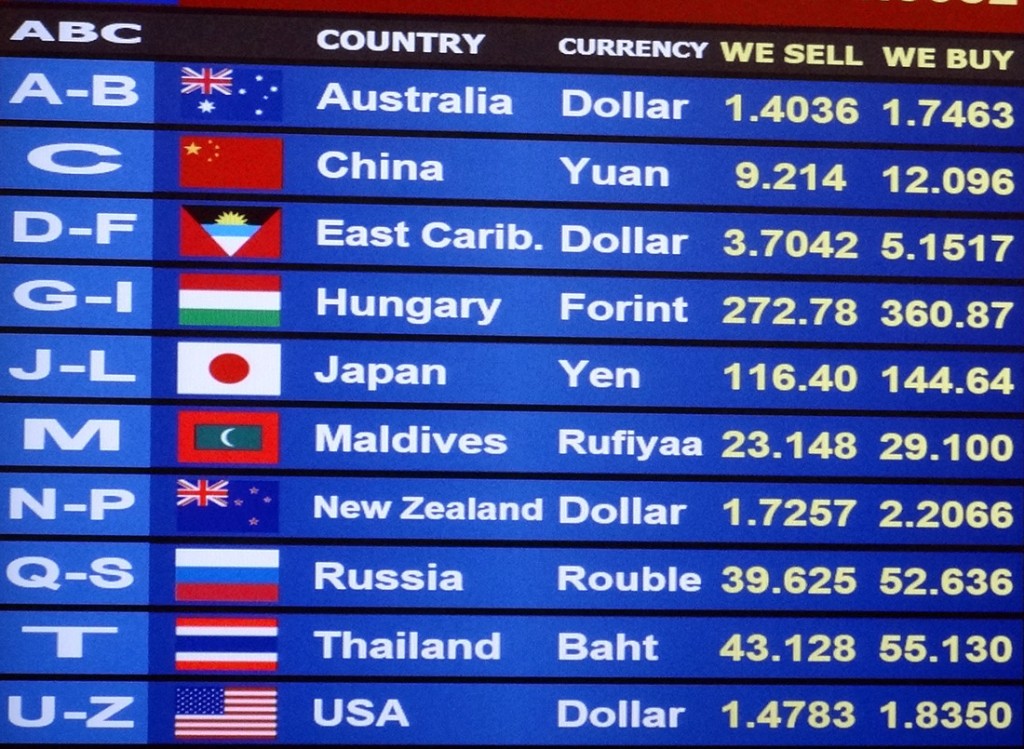 In light of the recent sharp decline in the British pound, this blog is an updated version of Appreciating a depreciating pound which was published in early December 2012. The significance of the depreciation should be seen in the context of the UK as an island-economy which makes trade an important determinant of our economic performance.
In light of the recent sharp decline in the British pound, this blog is an updated version of Appreciating a depreciating pound which was published in early December 2012. The significance of the depreciation should be seen in the context of the UK as an island-economy which makes trade an important determinant of our economic performance.
The competitiveness of our exports is, in part, affected by the exchange rate. Floating exchange rates are notoriously volatile. However, since the autumn of 2007 we have observed a significant depreciation of the UK exchange rate – a depreciation that seems to have found new momentum of late. A depreciation helps to make our exports more competitive abroad which might help to compensate for weak demand here in the UK.
Rather than look at the British pound (or any currency) against the many foreign currencies separately we can look at the average exchange rate against a whole bundle of currencies. The average rate is calculated by weighting the individual exchange rates by the amount of trade between Britain and the other countries. This trade-weighted exchange rate is known as the effective exchange rate.
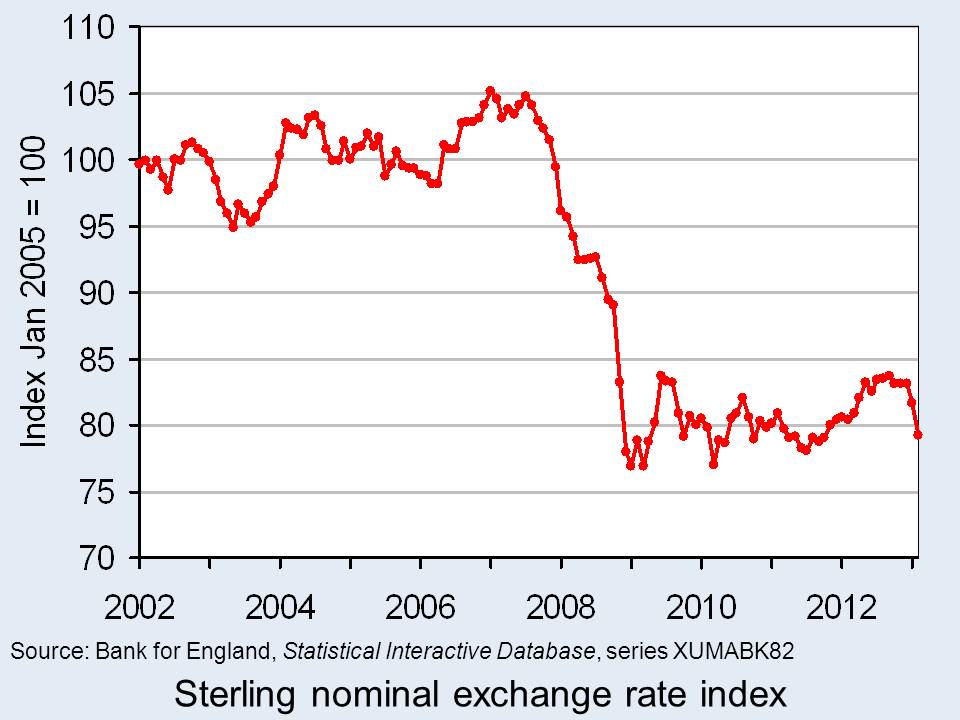
The chart shows the nominal (actual) effective exchange rate for the British pound since 2002. The chart shows clearly how from the autumn of 2007 the effective exchange rate began to fall sharply. Over the period from September 2007 to January 2009, figures from the Bank of England show that the nominal effective exchange rate fell by 25.3 per cent. In simple terms, the British pound depreciated by close to one-quarter. (Click here for a PowerPoint of the chart.)
If we move the clock forward, we observe an appreciation of the British pound between July 2011 (when its value was only 1.6 per cent higher than in January 2009) and September 2012. Over this period, the British pound appreciated by 7.2 per cent. Its value remained relatively stable through much of the remainder of last year. However, we appear to be on another downward path. If we compare the average value in February 2013 with the ‘high’ back in September 2012 we observe a depreciation of 5.4 per cent.
The British pound continues on its roller-coaster ride. Most commentators expect the British pound to fall further. Some see this as an important ingredient for a revival in British economic fortunes. If we compare September 2007 with February 2013, we find that the nominal effective exchange rate for the British pound is 23 per cent lower. This constitutes a major competitive boost for our exporters. However, an important question is whether there is a demand for these goods and services abroad however more attractive the depreciation makes them.
Data
Statistical Interactive Database – interest and exchange rate rates data Bank of England
BIS effective exchange rate indices Bank for International Settlements
Articles
Pound depreciates Vs dollar to lowest level since Aug 16 Bloomberg, Emma Charlton (5/2/13)
Pound advances against euro on Italy speculation; Gilts decline Bloomberg, Lucy Meakin and David Goodman (4/3/13)
Pounding of sterling risks a currency war Scotland on Sunday, Bill Jamieson (17/2/13)
Credit ratings, the pound, currency movements and you BBC News, Kevin Peachey (25/2/13)
The Bank of England can’t just go on doing down the pound Telegraph, Jeremy Warner (21/2/13)
 Sterling will continue to go down BBC News, Jim Rogers (25/2/13)
Sterling will continue to go down BBC News, Jim Rogers (25/2/13)
Questions
- Explain how the foreign demand for goods and assets generates a demand for British pounds. How will this demand be affected by the foreign currency price of the British pound, i.e. the number of foreign currency units per £1?
- Explain how the demand by British residents for foreign goods and assets generates a supply of British pounds. How will this supply be affected by the foreign currency price of the British pound, i.e. the number of foreign currency units per £1?
- What factors are likely to shift the demand and supply curves for British pounds on the foreign exchange markets?
- Illustrate the effect of a decrease in the demand for British goods and assets on the exchange rate (i.e. the foreign currency price of the British pound) using a demand-supply diagram.
- What is the difference between a nominal and a real effective exchange rate? Which of these is a better indicator of the competitiveness of our country’s exports
- What factors are likely to have caused the depreciation of the British pound in 2013?
Two reports on business confidence in the UK have just been published. The first, by Lloyds TSB Commercial, is its twice-yearly Business in Britain Report. The second is the Quarterly Economic Survey by the British Chambers of Commerce. Both reports paint a mixed picture about business confidence.
First the good news: the export sector is booming. Demand for exports is being boosted by (a) the depreciation of the pound, with the sterling exchange rate index some 20% lower now compared with the start of 2008 and (b) rapid economic growth in China, India and many other developing countries. Not surprisingly many exporting companies are looking to a bright future and are willing to invest.
Now the bad news. Domestic demand for many products is declining, especially services. This is not surprising given the rise in VAT, cuts in public spending and consumers cautious about their employment and income prospects in the coming year. With rapid cost-push inflation from higher oil and commodity prices, real incomes are set to fall and with it the level of real consumer demand (see Bosses gain – workers’ pain).
So where is the economy heading? The mixed picture painted by the two reports mean that the economy is likely to remain on the cusp. But with the export sector being much smaller than the domestic market, worries are likely to persist that economic growth may well slow significantly and the economy might return to recession. The main hope is that the restocking and replacement investment that follow a recession may be enough to provide just enough extra demand to avoid the ‘double dip’.
Articles
UK Business Confidence Hit By Domestic Demand Fears-Survey NASDAQ, Emma Haslett (4/1/11)
More doom and gloom as business confidence falls? Management Today, Nicholas Winning (5/1/11)
Smaller businesses do not share optimism Financial Times, Brian Groom (5/1/11)
New Year business confidence hit by domestic demand fears The Telegraph, James Hurley (5/1/11)
UK’s fragile services sector risks undermining recovery, BCC warns The Telegraph, Philip Aldrick (11/1/11)
Companies fear double-dip recession Oxford Mail, Andrew Smith (10/1/11)
Firms ‘planning investment freezes’ Press Association (4/1/11)
Surveys paint bleak picture for British economy Reuters, David Milliken (11/1/11)
 Kern Says U.K. Services Industry Growth Is `Mediocre’ Bloomberg, Watch Video, David Kern (11/1/11)
Kern Says U.K. Services Industry Growth Is `Mediocre’ Bloomberg, Watch Video, David Kern (11/1/11)
UK economic growth rate slowing, BCC says BBC News (11/1/11)
Reports
Business in Britain, December 2010 Lloyds TSB Commercial (January 2011)
Quarterly Economic Survey, Q4 2010: Summary British Chambers of Commerce (January 2011)
Quarterly Economic Survey, Q4 2010: Tables British Chambers of Commerce (January 2011)
Data
Interest Rates and Exchange Rates Bank of England (for sterling effective exchange rates)
Economic and Labour Market Review Office for National Statistics (see Tables Chapter 1, worksheets in Table 1.03 for components of aggregate demand)
Business and Consumer Surveys European Commission, Economic and Financial Affairs (see latest ESI – Economic Sentiment Indicator, Table 1)
Questions
- Summarise the findings of the two reports.
- Using the data in Table 1.03 of the Economic and Labour Market Review, calculate the percentage of UK GDP accounted for by each of the main elements of aggregate expenditure.
- Why is the manufacturing sector as a whole experiencing relatively strong economic growth?
- If the service sector shrank by x% and the manufacturing sector grew by x%, what would be likely to happen to the rate of economic growth in the economy? What else would you need to know to establish the precise rate of economic growth?
- The BCC said both the government and the Bank of England must “act forcefully to support growth”. What measures would this include?
- If real wages fall, what could cause real aggregate demand to rise in these circumstances?
- What is likely to drive the level of investment in the coming months?
 Japan has suffered from deflation on and off for more than 20 years. A problem with falling prices is that they discourage spending as people wait for prices to fall further. One of the three elements of the Japanese government’s macroeconomic policy (see Japan’s three arrows) has been expansionary monetary policy, including aggressive quantitative easing. A key aim of this is to achieve an inflation target of 2% and, hopefully, propel the economy out of its deflationary trap.
Japan has suffered from deflation on and off for more than 20 years. A problem with falling prices is that they discourage spending as people wait for prices to fall further. One of the three elements of the Japanese government’s macroeconomic policy (see Japan’s three arrows) has been expansionary monetary policy, including aggressive quantitative easing. A key aim of this is to achieve an inflation target of 2% and, hopefully, propel the economy out of its deflationary trap. If Japanese recovery is to be sustained and broadly based, a growth in real wages should be a core component. As it is, real wages are not growing. This could seriously constrain the recovery. For real wages to grow, employers need to be convinced that economic recovery will be sustained and that it would be profitable to take on more labour.
If Japanese recovery is to be sustained and broadly based, a growth in real wages should be a core component. As it is, real wages are not growing. This could seriously constrain the recovery. For real wages to grow, employers need to be convinced that economic recovery will be sustained and that it would be profitable to take on more labour.









